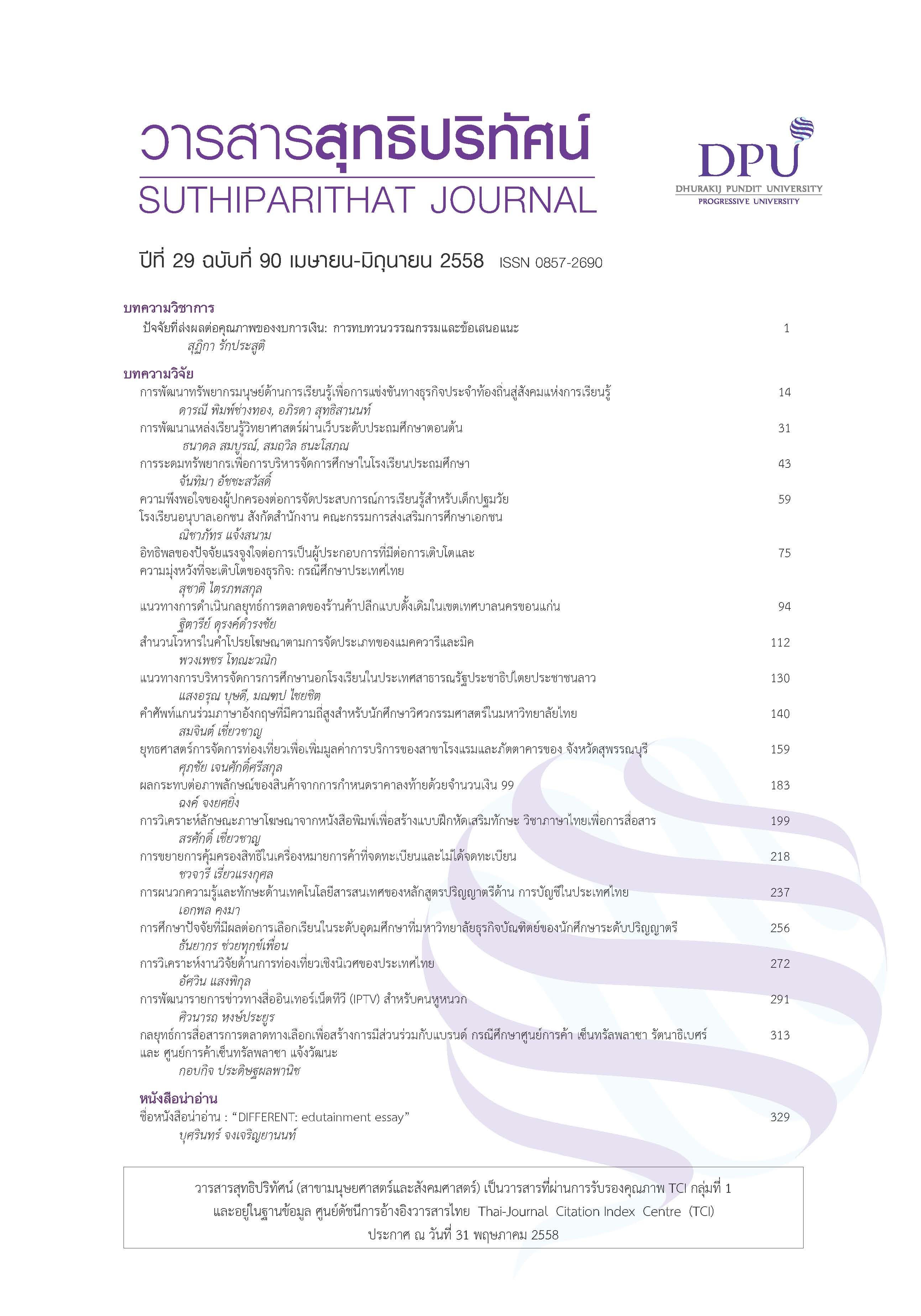คำศัพท์แกนร่วมภาษาอังกฤษที่มีความถี่สูงสำหรับนักศึกษาวิศวกรรมศาสตร์ในมหาวิทยาลัยไทย
คำสำคัญ:
คำศัพท์ที่มีความถี่สูง, คำศัพท์แกนร่วมภาษาอังกฤษ, นักศึกษาวิศวกรรมศาสตร์ในมหาวิทยาลัยไทย, คำศัพท์ทั่วไปที่ใช้มาก 2000 คำแรก, คำศัพท์วิชาการ 570 คำแรกบทคัดย่อ
งานวิจัยนี้มีวัตถุประสงค์เพื่อ (1) ตรวจสอบหาจำนวนและความถี่ในการปรากฏใช้ของคำศัพท์ทั่วไปที่ใช้มาก 1000 คำแรก รวมคำบอกหน้าที่และ 1000 คำหลัง รวมทั้งคำศัพท์วิชาการ 570 คำแรก ในตำราภาษาอังกฤษด้านวิศวกรรมศาสตร์ 9 เล่มที่มีการใช้สูง (2) สร้างรายการคำศัพท์ทั่วไปและรายการคำศัพท์วิชาการจากคลังข้อมูลที่เก็บจากตำราวิศวกรรมศาสตร์ 9 เล่ม อิงคำศัพท์ทั่วไปที่ใช้มาก 2000 คำแรก และคำศัพท์วิชาการ 570 คำแรก (3) ค้นหาความต่างในการแจกแจง หมวดคำของคำศัพท์ประเภทเนื้อหาในรายการคำศัพท์วิชาการที่สร้างจากคลังข้อมูลที่เก็บจากตำราวิศวกรรมศาสตร์ 9 เล่ม (4) จัดทำรายการคำศัพท์แกนร่วมภาษาอังกฤษที่มีความถี่ในการปรากฏใช้สูงสำหรับอ่านตำราวิศวกรรมศาสตร์ให้กับนักศึกษาวิศวกรรมศาสตร์ไทย ข้อมูลที่ใช้เป็นตำราวิศวกรรมศาสตร์รูปแบบออนไลน์ ใช้ในวิชาพื้นฐานด้านวิศวกรรม 5 รายวิชา ได้แก่ เขียนแบบวิศวกรรม กลศาสตร์วิศวกรรม วัสดุวิศวกรรม โปรแกรมคอมพิวเตอร์และวิศวกรรมไฟฟ้า จำนวน 9 เล่ม รวมคำศัพท์ 1,589,065 คำ วิเคราะห์ข้อมูลด้วยโปรแกรมประมวลผลคำแยกเป็นรายการ คำศัพท์ทั่วไปและรายการคำศัพท์วิชาการ วิเคราะห์ความสัมพันธ์คำศัพท์ประเภทเนื้อหาในรายการ คำศัพท์วิชาการกับตำรา โดยการทดสอบไคสแควร์ ประกอบค่าความถี่แบบร้อยละ เสนอผลการวิจัย โดยอิงไวยากรณ์ของเควิกและกรีนบอม (1976) โดยพบว่า มีการใช้คำศัพท์ทั่วไปที่ใช้มาก 1000 คำแรก และ 1000 คำหลัง รวมทั้งคำศัพท์วิชาการ 570 คำแรก คิดเป็น 65.4% 5.6% และ 8.6% ตามลำดับ ค่าไคสแควร์เท่ากับ 5,404.24 มีนัยสำคัญ ที่ระดับ .0001 ทั้งนี้ ผลการศึกษาแสดงให้ เห็นว่าการใช้คำศัพท์ประเภทเนื้อหาในรายการคำศัพท์วิชาการที่สร้างจากคลังข้อมูลที่เก็บจากตำรา วิศวกรรมศาสตร์ 9 เล่ม แตกต่างกันอย่างมาก คิดเป็นคำนาม 60% คำกริยา 20% คำคุณศัพท์ 17% และคำกริยาวิเศษณ์ 3% แสดงให้เห็นว่าตำราภาษาอังกฤษด้านวิศวกรรมศาสตร์มีการใช้คำศัพท์ภาษาอังกฤษที่มีความถี่ในการปรากฏสูง
เอกสารอ้างอิง
Association of Southeast Asian Nations. (2012). ASEAN Communities. Retrieved June 27, 2013, from http://www.asean.org/communities/asean- economic-community.
British National Corpus. BNC electronic list. Retrieved June 27, 2013, from http://www.natcorp.ox.ac.uk/,2012.
Callister, W. D. (2001). Fundamentals of Materials Science and Engineering. (5th ed.). New York: John Wiley & Sons.
Chung, T., & Nation, P. (2003). Technical vocabulary in specialised texts. Reading in a Foreign Language, 15(2), 103-116.
Chung, T., & Nation, P. (2004). Identifying technical vocabulary. System, 32(2), 251-263.
Council of Engineers of Thailand (COE). (2010). Basic Engineering. Retrieved June 30, 2013, from http://www.coe.or.th/_coe/_coenew/mainIndex.php?aMenu=8.
Coxhead, A. (2000). A new academic word list. TESOL Quarterly, 34(2), 213-238.
Floyd, T. L. (2005). Electronic Devices. (7th ed.). Upper Saddle River, NJ: Prentice Hall.
Floyd, T. L. (2007). Principles of Electric Circuits. (8th ed.). Upper Saddle River, NJ: Prentice Hall.
Goulden, R., Nation, P., & Read, J. (1990). How large can a receptive vocabulary be? Applied Linguistics,11(4), 341-363.
Heatley, A., Nation, P., & Coxhead, A. (2002). RANGE and FREQUENCY programs. Retrieved May 28, 2012, from http://www.vuw.ac.nz/lals/staff/Paul_Nation.
Hibbeler, R.C. (2010). Engineering Mechanics- Dynamics. (12 th ed.). Upper Saddle River, NJ: Prentice Hall.
Hibbeler, R.C. (2010). Engineering Mechanics- Statics. (12 th ed.). Upper Saddle River, NJ: Prentice Hall.
Hwang, K., & Nation, P. (1995). Where would general service vocabulary stop and special purposes vocabulary begin? System, 23(1), 35-41.
Liberty, J. (2001). Programming C#. Sebastopol, CA: O’Reilly & Associates. Martini, J. (2012). High Frequency Vocabulary in a Secondary Quebec ESL Textbook Corpus. MA Thesis, Concordia University, Montreal, Quebec, Canada.
Matsuoka, W., & Hirsh, D. (2010). Vocabulary learning through reading: Does an ELT course book provide good opportunities? Reading in a Foreign Language, 22(1), 56-70.
Ministry of Education Thailand. (2008). The Basic Education Core Curriculum 2008. Bangkok: Kurusapa Ladprao. Retrieved June 30, 2013, from http://www.curriculum51.net/viewpage.php?tid=95
Moiinvaziri, M. (2012). Analyzing Vocabulary Used in Payame Noor University General English Textbook: a Corpus Linguistic Approach. Frontiers of Language and Teaching, 3, 204-212.
Moudraya, O. (2006). Engineering English: A lexical frequency instructional model. English for Specific Purpose, 25, 235-256.
Nation, P. (2001). Learning vocabulary in another language. Cambridge: Cambridge University Press.
Nation, P. (2004). A study of the most frequent word families in the British National Corpus. In Bogaards, Nation, P., & Laufer, B. (Eds.)..Vocabulary in a Second Language: Selection, Acquisition and Testing. Amsterdam: John Benjamins: pp.3-13.
Nation, P. (2006). How large a vocabulary is needed for reading and listening? Canadian Modern Language Review, 63(1), 59-82.
Nation, P. (2012). Measuring vocabulary size in an uncommonly taught language. Retrieved June 27, 2013,
from http://www.sti.chula.ac.th/files/conference%20file/doc/paul%20nation.pdf.
Nation, P., & Meara, P. (2010). Vocabulary. In Schmitt, N. (Ed.), An Introduction to Applied Linguistics, (2 nd ed.), pp. 34-52. London: Hodder Education.
Nation, P., & Waring, R. (1997). Vocabulary size, text coverage, and word lists. In Vocabulary: Description, Acquisition and Pedagogy. Schmitt, N. and Quirk, R., & Greenbaum, S. (1976). A University Grammar of English.
London: Longman.
Schmitt, N. (2000). Vocabulary in language teaching. Cambridge: Cambridge University Press.
Sutarsyah, C., Nation, P., & Kennedy, G. (1994). How useful is EAP vocabulary for ESP? A corpus based case study. RELC Journal, 25(2), 34-50.
Tickoo, S. (2001). Pro/Engineer for Designers. CADCIM Technologies.
Wan-a-rom, U. (2012). Lexical Evaluation of Teacher-made Coursebooks: Thai Case Studies of Foundation English Courses at Tertiary Level. English Language Teaching, 5(8),146-156.
Warne, D. F. (2000). Newnes Electrical Engineer’s Handbook. Oxford: Butter worth-Heinemann.
West, M. (1953). A General Service List of English Words. London : Longman, Green & Co.
Xue, G., & Nation, P. (1984). A University Word List. Language Learning and Communication, 3(2), 215-229.
Zechmeister, E.B., Chronis, A.M., Cull, W.L., D’Anna, C.A., & Healy, N.A. (1995). Growth of a functionally Important lexicon. Journal of Reading Behavior, 27(2), 201-212.
Zelle, M.J. (2002). Python Programming: An Introduction to Computer Science. Wartburg College.
ดาวน์โหลด
เผยแพร่แล้ว
รูปแบบการอ้างอิง
ฉบับ
ประเภทบทความ
สัญญาอนุญาต
เนื้อหาและข้อมูลในบทความที่ลงตีพิมพ์ในวารสารสุทธิปริทัศน์ ถือเป็นข้อคิดเห็นและความรับผิดชอบของผู้เขียนบทความโดยตรงซึ่งกองบรรณาธิการวารสาร ไม่จำเป็นต้องเห็นด้วย หรือร่วมรับผิดชอบใด ๆ
บทความ ข้อมูล เนื้อหา รูปภาพ ฯลฯ ที่ได้รับการตีพิมพ์ในวารสารสุทธิปริทัศน์ ถือเป็นลิขสิทธิ์ของวารสารสุทธิปริทัศน์หากบุคคลหรือหน่วยงานใดต้องการนำทั้งหมดหรือส่วนหนึ่งส่วนใดไปเผยแพร่ต่อหรือเพื่อกระทำการใด ๆ จะต้องได้รับอนุญาตเป็นลายลักษณ์อักษรจากวารสารสุทธิปริทัศน์ก่อนเท่านั้น







